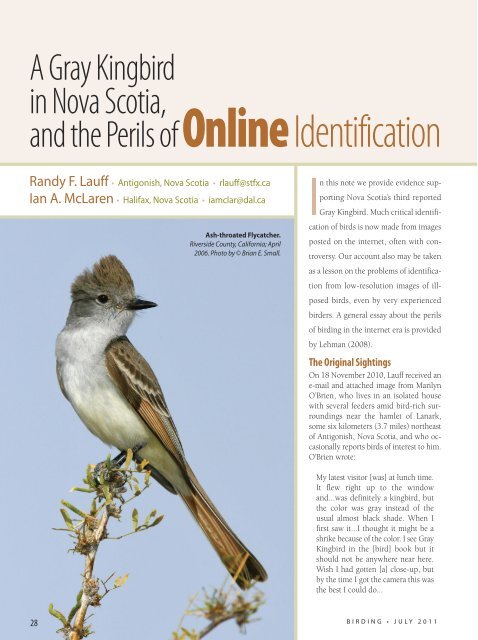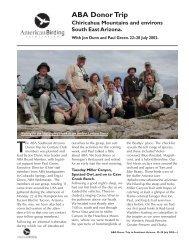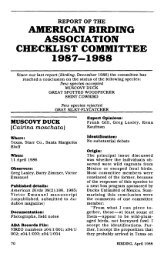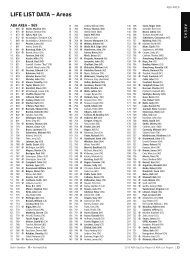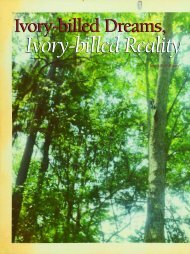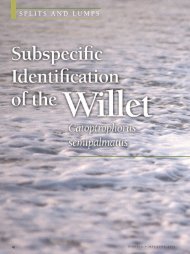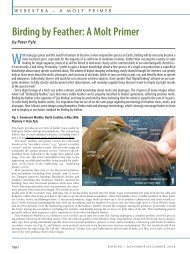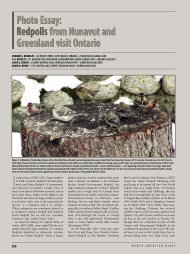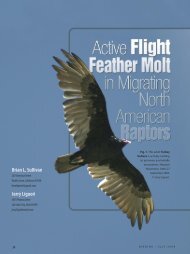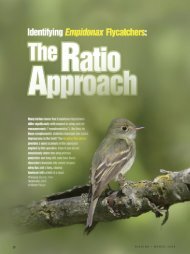A Gray Kingbird in Nova Scotia, and the Perils of Online Identification
A Gray Kingbird in Nova Scotia, and the Perils of Online Identification
A Gray Kingbird in Nova Scotia, and the Perils of Online Identification
You also want an ePaper? Increase the reach of your titles
YUMPU automatically turns print PDFs into web optimized ePapers that Google loves.
A <strong>Gray</strong> <strong>K<strong>in</strong>gbird</strong><strong>in</strong> <strong>Nova</strong> <strong>Scotia</strong>,<strong>and</strong> <strong>the</strong> <strong>Perils</strong> <strong>of</strong> Onl<strong>in</strong>e <strong>Identification</strong>R<strong>and</strong>y F. Lauff • Antigonish, <strong>Nova</strong> <strong>Scotia</strong> • rlauff@stfx.caIan A. McLaren • Halifax, <strong>Nova</strong> <strong>Scotia</strong> • iamclar@dal.caAsh-throated Flycatcher.Riverside County, California; April2006. Photo by © Brian E. Small.n this note we provide evidence support<strong>in</strong>g<strong>Nova</strong> <strong>Scotia</strong>’s third reported<strong>Gray</strong> <strong>K<strong>in</strong>gbird</strong>. Much critical identification<strong>of</strong> birds is now made from imagesposted on <strong>the</strong> <strong>in</strong>ternet, <strong>of</strong>ten with controversy.Our account also may be takenas a lesson on <strong>the</strong> problems <strong>of</strong> identificationfrom low-resolution images <strong>of</strong> illposedbirds, even by very experiencedbirders. A general essay about <strong>the</strong> perils<strong>of</strong> bird<strong>in</strong>g <strong>in</strong> <strong>the</strong> <strong>in</strong>ternet era is providedby Lehman (2008).The Orig<strong>in</strong>al Sight<strong>in</strong>gsOn 18 November 2010, Lauff received ane-mail <strong>and</strong> attached image from MarilynO’Brien, who lives <strong>in</strong> an isolated housewith several feeders amid bird-rich surround<strong>in</strong>gsnear <strong>the</strong> hamlet <strong>of</strong> Lanark,some six kilometers (3.7 miles) nor<strong>the</strong>ast<strong>of</strong> Antigonish, <strong>Nova</strong> <strong>Scotia</strong>, <strong>and</strong> who occasionallyreports birds <strong>of</strong> <strong>in</strong>terest to him.O’Brien wrote:My latest visitor [was] at lunch time.It flew right up to <strong>the</strong> w<strong>in</strong>dow<strong>and</strong>...was def<strong>in</strong>itely a k<strong>in</strong>gbird, but<strong>the</strong> color was gray <strong>in</strong>stead <strong>of</strong> <strong>the</strong>usual almost black shade. When Ifirst saw it...I thought it might be ashrike because <strong>of</strong> <strong>the</strong> color. I see <strong>Gray</strong><strong>K<strong>in</strong>gbird</strong> <strong>in</strong> <strong>the</strong> [bird] book but itshould not be anywhere near here.Wish I had gotten [a] close-up, butby <strong>the</strong> time I got <strong>the</strong> camera this was<strong>the</strong> best I could do...28B I R D I N G • J U L Y 2 0 1 1
Later that day, Lauff received ano<strong>the</strong>r e-mail messagefrom O’Brien. It read:Crazy as all this seems, I actually saw ano<strong>the</strong>rflycatcher this afternoon. This one wassmaller, leaner, <strong>and</strong> [had] chestnut outerw<strong>in</strong>gs <strong>and</strong> yellow flanks...It came back severaltimes but <strong>in</strong> my haste to get a still shotI lost out because my digital camera is relativelynew <strong>and</strong> I don’t “get <strong>the</strong> hang <strong>of</strong> it” yet.I did manage however to get a video <strong>of</strong> thissecond bird...wonder<strong>in</strong>g after this day if flycatchersactually flock toge<strong>the</strong>r at this season.The second bird I saw was certa<strong>in</strong>lysmaller, leaner <strong>and</strong> with <strong>the</strong> mark<strong>in</strong>gs alreadydescribed. The one I saw earlier wasimpressive with its size, all white breast <strong>and</strong>complete grayness o<strong>the</strong>rwise...It is not anEastern <strong>K<strong>in</strong>gbird</strong> because it [did] not have<strong>the</strong> white tail fr<strong>in</strong>ge. On <strong>the</strong> o<strong>the</strong>r h<strong>and</strong>, if itis a <strong>Gray</strong> <strong>K<strong>in</strong>gbird</strong>, I cannot see <strong>the</strong> fork <strong>in</strong><strong>the</strong> tail...If I manage to [get] ano<strong>the</strong>r photoor get to diagnose <strong>the</strong> second bird, I’ll getback to you. Sorry I did not get a betterphoto <strong>of</strong> <strong>the</strong> first bird, though, because itwas right <strong>in</strong> my face through <strong>the</strong> w<strong>in</strong>dow.It should be noted that late on 18 November,upon request by Lauff, O’Brien responded,“When [<strong>the</strong> bird] was right ‘<strong>in</strong> my face,’ I did notsee a mask.” The image <strong>of</strong> <strong>the</strong> first bird was sentto Lauff <strong>in</strong> low resolution, with <strong>the</strong> bird’s lengthonly about 5% <strong>of</strong> <strong>the</strong> frame width. The next day,Lauff reported <strong>the</strong> bird to <strong>the</strong> <strong>Nova</strong> <strong>Scotia</strong> rarebird alert (NS-RBA), <strong>and</strong> he placed <strong>the</strong> uncroppedimage—which he underst<strong>and</strong>ably characterizedas “not even diagnostic”—on hiswebsite; this image is reproduced on p. 31.<strong>Gray</strong> <strong>K<strong>in</strong>gbird</strong>. Key WestBotanical Gardens, Florida; April 1996.Photo by © Kev<strong>in</strong> T. Karlson–VIREO.High-quality photos <strong>of</strong> conveniently posed birds generally do not present challenges for experienced students <strong>of</strong> birdidentification. For example, both <strong>the</strong> <strong>Gray</strong> <strong>K<strong>in</strong>gbird</strong> (above) <strong>and</strong> Ash-throated Flycatcher (left) are easily identified <strong>in</strong> <strong>the</strong>photos shown here. But rare birds <strong>of</strong>ten do not pose long enough to allow crisp photos show<strong>in</strong>g diagnostic field marks.In this article, we consider <strong>the</strong> difficulties presented by a gra<strong>in</strong>y photo <strong>of</strong> an <strong>in</strong>conveniently posed flycatcher far out <strong>of</strong>range <strong>in</strong> <strong>Nova</strong> <strong>Scotia</strong>. To be sure, <strong>the</strong> <strong>in</strong>ternet revolution has led to a proliferation <strong>of</strong> photo-documented rarities that wouldhave “gotten away” <strong>in</strong> <strong>the</strong> past. But as this article alerts us, onl<strong>in</strong>e photo identification is not without its challenges.W W W . A B A . O R G 29
P E R I L S O F O N L I N E I D E N T I F I C A T I O NMcLaren believed <strong>the</strong> photo to be <strong>of</strong> a <strong>Gray</strong> <strong>K<strong>in</strong>gbird</strong>, <strong>in</strong>creas<strong>in</strong>glynoted as a vagrant <strong>in</strong> <strong>the</strong> fall to <strong>the</strong> Atlantic coastnorth <strong>of</strong> North Carol<strong>in</strong>a (Armistead <strong>and</strong> Iliff 2003). So he solicitedop<strong>in</strong>ions regard<strong>in</strong>g <strong>the</strong> low-resolution image from contributorsto <strong>the</strong> onl<strong>in</strong>e “Frontiers <strong>of</strong> Field <strong>Identification</strong>”(hereafter, F-ID) discussion group . Additionaldetails <strong>and</strong> context (for example, <strong>the</strong> observer’s e-mailmessage to Lauff) were not provided to F-ID; only <strong>the</strong> photoitself was submitted for discussion. As a result <strong>of</strong> his <strong>in</strong>quiry,McLaren received more than 30 public <strong>and</strong> private responses,<strong>in</strong>clud<strong>in</strong>g multiple responses from a few respondents.A Sight<strong>in</strong>g <strong>the</strong> Next DayFulton L. Lavender, an experienced birder, observed <strong>the</strong> k<strong>in</strong>gbirdat 9:15 a.m. <strong>the</strong> next morn<strong>in</strong>g, 19 November 2010, whilehis two companions were unfortunately look<strong>in</strong>g elsewhere. Inhis account, Lavender says:I stepped to my right to get a better view <strong>of</strong> <strong>the</strong> yard <strong>and</strong>immediately noticed a large, gray-<strong>and</strong>-white, blackbirdsizedk<strong>in</strong>gbird perched horizontally, side on, below twoBlue Jays, on <strong>the</strong> bottom rail <strong>of</strong> <strong>the</strong> back fence, perhaps 20meters away. I took a few seconds to note some critical fieldmarks <strong>and</strong> <strong>the</strong>n attempted to get [a companion’s] attention.As I began to speak...<strong>the</strong> k<strong>in</strong>gbird flipped over <strong>the</strong> fence<strong>and</strong> dropped out <strong>of</strong> sight...The rest <strong>of</strong> <strong>the</strong> cold, viciouslyw<strong>in</strong>dy day was spent <strong>in</strong> a fruitless search for <strong>the</strong> bird.Lavender noted <strong>the</strong> follow<strong>in</strong>g field marks dur<strong>in</strong>g his fairly briefsight<strong>in</strong>g:Structure: Large, heavy headed with rounded crown; verylong, heavy bill, almost disproportionate for <strong>the</strong> size <strong>of</strong><strong>the</strong> bird; proportionally short-w<strong>in</strong>ged <strong>and</strong> long-tailed;fairly long, heavy feet for a k<strong>in</strong>gbird; tail was slightlyfolded. No fork was discernable. Color: underbody whitefrom throat to undertail coverts; rear flanks with a bit <strong>of</strong>gray divid<strong>in</strong>g undertail from flanks; upper body gray, <strong>in</strong>clud<strong>in</strong>gcrown (very dark <strong>in</strong> centre, may have been wet),nape, back, rump, uppertail, coverts <strong>and</strong> upper tail; lesser,median, greater, marg<strong>in</strong>al coverts <strong>and</strong> primaries darkergray, secondaries paler; no w<strong>in</strong>g bars; tertials black withwhite edg<strong>in</strong>gs; face with a blackish mask, contrast<strong>in</strong>g withgray crown; underw<strong>in</strong>gs whitish. Voice: No call noteswere heard.Critical Analyses <strong>of</strong> <strong>the</strong> ImagesThe images obta<strong>in</strong>ed by O’Brien 18 November clearly showtwo very different birds. The first (<strong>in</strong>set, p. 31), which iscropped from <strong>the</strong> high-resolution orig<strong>in</strong>al, appears to beperched nearly parallel to <strong>the</strong> measured foreground limb, withits head po<strong>in</strong>ted to <strong>the</strong> right directly away from <strong>the</strong> camera. Itis <strong>in</strong> first-fall (“formative”) plumage, judg<strong>in</strong>g by its blunt,rounded primary tips, among o<strong>the</strong>r features. Above it is grayfrom <strong>the</strong> crown to <strong>the</strong> tip <strong>of</strong> tail, but with brownish washes onparts <strong>of</strong> <strong>the</strong> crown, mantle, <strong>and</strong> tail. It has prom<strong>in</strong>ently whitemarg<strong>in</strong>edtertials. There are whitish marg<strong>in</strong>s at <strong>the</strong> edges <strong>of</strong><strong>the</strong> greater coverts, <strong>and</strong> a h<strong>in</strong>t <strong>of</strong> one on an outer mediancovert, but noth<strong>in</strong>g that might be termed a w<strong>in</strong>g bar. There isno h<strong>in</strong>t <strong>of</strong> yellow on <strong>the</strong> exposed flank. Some confus<strong>in</strong>g backgroundfeatures have been clarified from later images <strong>and</strong> avisit to <strong>the</strong> scene by Lauff (see <strong>in</strong>set, p. 31).The less-focused image <strong>of</strong> <strong>the</strong> second bird (p. 30) shows abird with a small bill, a pale gray breast, <strong>and</strong> a pale yellow belly<strong>and</strong> flanks. Its head <strong>and</strong> forew<strong>in</strong>g are gray-brown, its back ispaler, <strong>and</strong> its h<strong>in</strong>d w<strong>in</strong>gs are a darker chestnut. There appearsAlthough blurry, <strong>the</strong>se videograbs are diagnostic, depict<strong>in</strong>g a rare Ash-throated Flycatcher <strong>in</strong> a Lanark, <strong>Nova</strong> <strong>Scotia</strong>, backyardon 18 November 2010. The existence <strong>of</strong> <strong>the</strong>se photos created an <strong>in</strong>terest<strong>in</strong>g psychological challenge for <strong>the</strong> photo-identification<strong>of</strong> ano<strong>the</strong>r, even rarer flycatcher species <strong>in</strong> <strong>the</strong> same yard on <strong>the</strong> same day. See text for details. From video made by © Marilyn O’Brien.30B I R D I N G • J U L Y 2 0 1 1
Where’s Waldo? Note <strong>the</strong> gray-<strong>and</strong>-white flycatcher <strong>in</strong> <strong>the</strong>upper right portion <strong>of</strong> <strong>the</strong> photo; this bird appeared <strong>in</strong> <strong>the</strong>same yard <strong>and</strong> on <strong>the</strong> same date as <strong>the</strong> bird depicted onp. 30. Birders who attempted to identify this bird—eventuallydeterm<strong>in</strong>ed to be <strong>Nova</strong> <strong>Scotia</strong>’s first photo-documented<strong>Gray</strong> <strong>K<strong>in</strong>gbird</strong>—were challenged by <strong>the</strong> problematic quality<strong>of</strong> <strong>the</strong> image, as well as by <strong>the</strong>ir own notions about what<strong>the</strong> bird was or wasn’t. Photo by © Marilyn O’Brien.to be a median-coverts w<strong>in</strong>g bar, but any o<strong>the</strong>r paleedg<strong>in</strong>gs on <strong>the</strong> bird’s greater coverts <strong>and</strong> flight fea<strong>the</strong>rsare presumably obscured by <strong>the</strong> w<strong>in</strong>g angle <strong>and</strong> poorfocus. It does not at all resemble <strong>the</strong> image <strong>of</strong> <strong>the</strong> firstbird, but it readily fits Ash-throated Flycatcher, a rarebut annual vagrant to <strong>the</strong> Atlantic coast from <strong>the</strong> mid-Atlantic region north to Atlantic Canada.Of those who commented on <strong>the</strong> orig<strong>in</strong>al, low-resolutionimage posted to F-ID, only three were for <strong>Gray</strong><strong>K<strong>in</strong>gbird</strong>, one was for a (tail-worn) Eastern <strong>K<strong>in</strong>gbird</strong>,six were for Ash-throated Flycatcher or some o<strong>the</strong>rMyiarchus, four were for Black Phoebe, <strong>and</strong> two wereIn this close-up, <strong>the</strong> arrows <strong>and</strong> annotations were used to obta<strong>in</strong>measurements analyzed <strong>in</strong> <strong>the</strong> text. The distance between <strong>the</strong> twosmall branches was measured by Lauff, who also determ<strong>in</strong>ed that<strong>the</strong> dark area left <strong>of</strong> <strong>the</strong> head is a background feature, <strong>and</strong> that <strong>the</strong>white areas beh<strong>in</strong>d <strong>the</strong> nape are magnolia buds. The small, pale, triangularfeature just beyond <strong>the</strong> arrowhead at <strong>the</strong> primary tip wasalso found to be a background feature, not a projection <strong>of</strong> <strong>the</strong> limbcutt<strong>in</strong>g <strong>of</strong>f a “true” primary tip beyond. Photo by © Marilyn O’Brien.W W W . A B A . O R G 31
P E R I L S O F O N L I N E I D E N T I F I C A T I O Nfor Eastern Phoebe. Three, perhaps wisely, considered <strong>the</strong> birdto be unidentifiable from <strong>the</strong> photo. Later, Lauff obta<strong>in</strong>ed <strong>the</strong>full-resolution image from <strong>the</strong> photographer. He also downloadedstill images from her video <strong>of</strong> <strong>the</strong> second flycatcher.Contributors to F-ID raised several objections to <strong>the</strong> identification<strong>of</strong> <strong>the</strong> first bird as a <strong>Gray</strong> <strong>K<strong>in</strong>gbird</strong>. O<strong>the</strong>r objectionswere raised <strong>in</strong> private exchanges with those contributors <strong>and</strong>by o<strong>the</strong>rs. Among <strong>the</strong> various objections, some certa<strong>in</strong>ly wererelated to <strong>the</strong> quality <strong>of</strong> image posted onl<strong>in</strong>e. O<strong>the</strong>rs were not.Here is a summary <strong>of</strong> <strong>the</strong> objections:1. The occurrence <strong>of</strong> two greatly displaced vagrant flycatcherson <strong>the</strong> same November day <strong>in</strong> <strong>the</strong> same backyardseemed highly improbable to some. Thus, some observersassumed that <strong>the</strong> reports from O’Brien’s yard <strong>in</strong> Lanarkmust have perta<strong>in</strong>ed to only one bird. However, laggardmigrants <strong>and</strong> vagrants <strong>in</strong> severe wea<strong>the</strong>r are well known toassociate with each o<strong>the</strong>r, perhaps because <strong>the</strong>y f<strong>in</strong>d highlylocal, reliable food sources <strong>and</strong>/or because <strong>the</strong>y recognizesimilar foragers. In this regard, we note that several warblerspecies are found rout<strong>in</strong>ely <strong>in</strong>to early w<strong>in</strong>ter <strong>in</strong> a shortstretch <strong>of</strong> p<strong>in</strong>es <strong>in</strong> Po<strong>in</strong>t Pleasant Park, Halifax, <strong>Nova</strong> <strong>Scotia</strong>.With regard to <strong>the</strong> present matter, we note thatO’Brien’s back yard conta<strong>in</strong>ed unharvested apples, whichare known to susta<strong>in</strong> fly<strong>in</strong>g <strong>in</strong>sects <strong>and</strong> attract <strong>in</strong>sectivorousbirds <strong>in</strong> early w<strong>in</strong>ter.2. The behavior <strong>of</strong> <strong>the</strong> bird, huddled on a low branch, was too“unk<strong>in</strong>gbird-like” for o<strong>the</strong>rs. However, remote vagrants <strong>in</strong>severe wea<strong>the</strong>r—<strong>the</strong> temperature was near freez<strong>in</strong>g on 18November—<strong>of</strong>ten behave unexpectedly. For example, a<strong>Gray</strong> <strong>K<strong>in</strong>gbird</strong> l<strong>in</strong>ger<strong>in</strong>g <strong>in</strong> November 2006 near <strong>the</strong> tip <strong>of</strong><strong>the</strong> Gaspé Pen<strong>in</strong>sula <strong>in</strong> Québec spent time feed<strong>in</strong>g on seabuckthorn (Hippophae rhamnoides) berries, <strong>and</strong> a publishedimage shows it perched on a low shrub (Bannon et al.2007). One respondent noted that a <strong>Gray</strong> <strong>K<strong>in</strong>gbird</strong> <strong>in</strong>Ma<strong>in</strong>e <strong>in</strong> early November 2010 spent some time perchedlow, <strong>and</strong> an <strong>in</strong>ternet image <strong>of</strong> that bird shows that bird huddledon thick spruce foliage . Ano<strong>the</strong>r<strong>in</strong>ternet photo <strong>of</strong> a <strong>Gray</strong> <strong>K<strong>in</strong>gbird</strong> 23 October 2010 atSavannah, New York, shows a bird perched on a branch <strong>in</strong><strong>the</strong> middle <strong>of</strong> a small tree .3. The <strong>in</strong>itial observer did not see a mask, although that markwas anticipated <strong>and</strong> noted by <strong>the</strong> second, experienced observer.The mask <strong>of</strong> <strong>the</strong> <strong>Gray</strong> <strong>K<strong>in</strong>gbird</strong> is not obvious onunderexposed or low-light <strong>in</strong>ternet images.4. Several people believed that <strong>the</strong> tertials were too prom<strong>in</strong>entlywhite marg<strong>in</strong>ed for <strong>Gray</strong> <strong>K<strong>in</strong>gbird</strong>, more resembl<strong>in</strong>gthose <strong>of</strong> Ash-throated Flycatcher. The image is “s<strong>of</strong>t,” <strong>and</strong>that may overemphasize breadth <strong>of</strong> <strong>the</strong> white fr<strong>in</strong>ges by render<strong>in</strong>gmarg<strong>in</strong>al pixels as white. This feature is very variableamong <strong>in</strong>ternet images; some, <strong>in</strong>clud<strong>in</strong>g two juvenilesshown <strong>in</strong> Birds <strong>of</strong> North America Onl<strong>in</strong>e (Smith <strong>and</strong> Jackson2002), have white marg<strong>in</strong>s as conspicuous as, or more sothan, those <strong>of</strong> <strong>the</strong> <strong>Nova</strong> <strong>Scotia</strong> bird.5. O<strong>the</strong>rs <strong>in</strong>voked <strong>the</strong> brownish washes on <strong>the</strong> crown, back,<strong>and</strong> tail <strong>of</strong> <strong>the</strong> bird as a trait for Ash-throated Flycatcher.However, Pyle (1997) notes for <strong>Gray</strong> <strong>K<strong>in</strong>gbird</strong> that <strong>the</strong> juvenile,from August until <strong>the</strong> second half <strong>of</strong> November, has“upperparts washed brownish.” The head, lower back,w<strong>in</strong>gs, <strong>and</strong> tail <strong>of</strong> a recently molted Ash-throated are considerablydarker <strong>and</strong> browner.Fur<strong>the</strong>r Analysis: The Ratio ApproachTo <strong>in</strong>vestigate <strong>the</strong> matter fur<strong>the</strong>r, we attempted to extract more<strong>in</strong>formation from <strong>the</strong> higher-resolution image us<strong>in</strong>g <strong>the</strong> measuredapproximately 223-millimeter distance between twobranches on <strong>the</strong> foreground limb (see <strong>in</strong>set, p. 31). If <strong>the</strong> birdwas perched reasonably parallel to that limb, <strong>the</strong>n its apparentsize would exclude both phoebes, but not Ash-throated Flycatcher.If <strong>the</strong> branch was parallel to <strong>the</strong> plane <strong>of</strong> <strong>the</strong> image,<strong>and</strong> <strong>the</strong> bird was perched at an angle, <strong>the</strong> bird could be evenlarger. But, if <strong>the</strong> bird was parallel to <strong>the</strong> plane <strong>of</strong> <strong>the</strong> image,<strong>and</strong> <strong>the</strong> measured branch was as much as 45 o <strong>of</strong>f that plane(very unlikely from <strong>in</strong>spection <strong>of</strong> <strong>the</strong> photo), simple geometrywould <strong>in</strong>dicate that <strong>the</strong> bird’s true size could fall with<strong>in</strong> <strong>the</strong>size range for <strong>the</strong> two phoebes.An alternative approach us<strong>in</strong>g ratios <strong>of</strong> measurements fromimages is more trouble-free. McLaren (1996) used this approachto help identify <strong>the</strong> prov<strong>in</strong>ce’s first confirmed AcadianFlycatcher, <strong>and</strong> it has recently been explored for separat<strong>in</strong>g <strong>the</strong>wood-pewees (Lee et al. 2008) <strong>and</strong> for resolv<strong>in</strong>g differencesamong Empidonax flycatchers (Rowl<strong>and</strong> 2009). Us<strong>in</strong>g such ratiosrequires only that <strong>the</strong> two measured parts be reasonablycoplanar. In <strong>the</strong> image <strong>of</strong> <strong>the</strong> first bird, <strong>the</strong> distance from <strong>the</strong>base <strong>of</strong> <strong>the</strong> exposed tertials (that is, <strong>the</strong> edge <strong>of</strong> <strong>the</strong> greatercoverts) to <strong>the</strong> tip <strong>of</strong> <strong>the</strong> primaries as a proportion <strong>of</strong> <strong>the</strong> distanceto <strong>the</strong> tip <strong>of</strong> <strong>the</strong> tail is 0.49. We also estimated this ratioon ten good <strong>in</strong>ternet images <strong>of</strong> <strong>the</strong> two large c<strong>and</strong>idate species,<strong>Gray</strong> <strong>K<strong>in</strong>gbird</strong> <strong>and</strong> Ash-throated Flycatcher; <strong>the</strong>se were birdsperched more or less broadside, with <strong>the</strong> w<strong>in</strong>gs <strong>and</strong> tail <strong>in</strong> l<strong>in</strong>ewith <strong>the</strong> body. For <strong>Gray</strong> <strong>K<strong>in</strong>gbird</strong>, <strong>the</strong> arithmetic mean <strong>of</strong> thisratio was found to be 0.51, with a range <strong>of</strong> 0.48–0.54. ForAsh-throated Flycatcher, <strong>the</strong> arithmetic mean was 0.43, witha range <strong>of</strong> 0.40–0.47. On this basis, <strong>the</strong> bird <strong>in</strong> O’Brien’s backyard <strong>in</strong> Lanark lies with<strong>in</strong> <strong>the</strong> range <strong>of</strong> <strong>Gray</strong> <strong>K<strong>in</strong>gbird</strong> but outside<strong>the</strong> limit <strong>of</strong> Ash-throated Flycatcher, consistent with <strong>the</strong>relatively short w<strong>in</strong>gs <strong>and</strong> long tail <strong>of</strong> Ash-throated.Ma<strong>the</strong>matically <strong>in</strong>cl<strong>in</strong>ed readers will be <strong>in</strong>terested to know32B I R D I N G • J U L Y 2 0 1 1
that we tested <strong>the</strong> statistical “fit” <strong>of</strong> <strong>the</strong> Lanark bird to <strong>the</strong> respectivec<strong>and</strong>idate species. For technical reasons, <strong>the</strong> ratioswere first transformed as arcs<strong>in</strong>e square roots; <strong>the</strong>n, means <strong>and</strong>st<strong>and</strong>ard deviations (SD) estimated for each <strong>in</strong>ternet sample<strong>of</strong> ten birds. These transformed estimates are as follows: for<strong>Gray</strong> <strong>K<strong>in</strong>gbird</strong>, mean=1.04, SD=0.024; for Ash-throated Flycatcher,mean=1.12, SD=0.029. The Lanark bird, with a transformedratio <strong>of</strong> 1.03, lies with<strong>in</strong> about 0.6 SD <strong>of</strong> <strong>the</strong> samplemean for <strong>Gray</strong> <strong>K<strong>in</strong>gbird</strong>; however, it is more than 3.3 SDs from<strong>the</strong> sample mean for Ash-throated Flycatcher. On this basis,<strong>the</strong> Lanark bird is not far from average for <strong>Gray</strong> <strong>K<strong>in</strong>gbird</strong>, butit has a less than 1% probability <strong>of</strong> be<strong>in</strong>g an Ash-throated Flycatcherbased on our measurements alone.e believe that field observations <strong>and</strong> digital images stronglysupport records <strong>of</strong> <strong>Nova</strong> <strong>Scotia</strong>’s first confirmed (<strong>and</strong> thirdreported) <strong>Gray</strong> <strong>K<strong>in</strong>gbird</strong> <strong>and</strong> third confirmed Ash-throatedFlycatcher <strong>in</strong> mid-November 2010. Intrigu<strong>in</strong>gly, but not implausibly,both are from <strong>the</strong> same yard on <strong>the</strong> same date. Theoccurrence <strong>of</strong> <strong>the</strong>se birds re<strong>in</strong>forces <strong>the</strong> lesson that low-resolutionimages <strong>of</strong> “ill-posed” rare birds can be mislead<strong>in</strong>g. Inthis digital era, photo documentation <strong>of</strong> rare birds is easy, <strong>and</strong>photo confirmation <strong>of</strong> <strong>the</strong>ir identifications <strong>of</strong>ten seemsstraightforward. As <strong>the</strong> Lanark flycatchers show, however, oldfashionedcritical analysis may still be required for <strong>the</strong> correctidentification <strong>of</strong> vagrants.Literature CitedArmistead, G. L. <strong>and</strong> M. J. Iliff. 2003. The vagrancy <strong>of</strong> <strong>Gray</strong> <strong>K<strong>in</strong>gbird</strong> <strong>in</strong>North America. North American Birds 57:148–161.Bannon, P., O. Barden, N. David, S. Denault, <strong>and</strong> Y. Aubry. Fall migration–Augustthrough November 2006: Québec. North AmericanBirds 61:33–35.Lee, C.-T., A. Birch, <strong>and</strong> T. L. Eubanks. 2008. Field identification <strong>of</strong> Western<strong>and</strong> Eastern wood-pewees. Bird<strong>in</strong>g 40(4):34–40.Lehman, P. 2008. Bird<strong>in</strong>g <strong>and</strong> <strong>the</strong> <strong>in</strong>ternet: The dark side. Bird<strong>in</strong>g40(1):36–40.McLaren, I. A. 1996. Acadian Flycatcher <strong>in</strong> <strong>Nova</strong> <strong>Scotia</strong>. Birders Journal5:194–195.Pyle, P. 1997. <strong>Identification</strong> Guide to North American Birds. Part I.Columbidae to Ploceidae. Slate Creek Press, Bol<strong>in</strong>as.Rowl<strong>and</strong>, F. 2009. Identify<strong>in</strong>g Empidonax flycatchers: The ratio approach.Bird<strong>in</strong>g 41(2):31–38.Smith, G. A. <strong>and</strong> J. A. Jackson. 2002. <strong>Gray</strong> <strong>K<strong>in</strong>gbird</strong> (Tyrannus dom<strong>in</strong>icensis),<strong>in</strong>: Birds <strong>of</strong> North America, ed. by A. Poole. Cornell Lab <strong>of</strong> Ornithology,Ithaca .W W W . A B A . O R G 33


